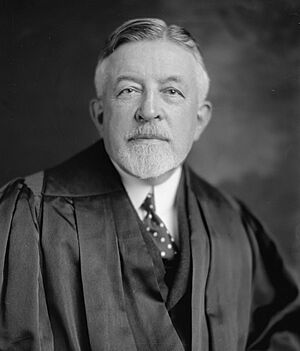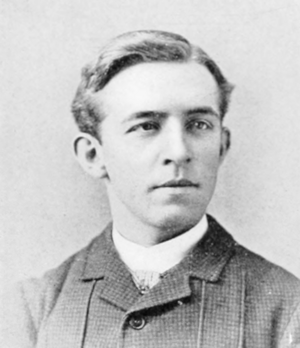Edward Terry Sanford facts for kids
Quick facts for kids
Edward Terry Sanford
|
|
|---|---|
 |
|
| Associate Justice of the Supreme Court of the United States | |
| In office February 19, 1923 – March 8, 1930 |
|
| Nominated by | Warren G. Harding |
| Preceded by | Mahlon Pitney |
| Succeeded by | Owen Roberts |
| Judge of the United States District Court for the Eastern District of Tennessee | |
| In office May 18, 1908 – February 5, 1923 |
|
| Nominated by | Theodore Roosevelt |
| Preceded by | Charles Dickens Clark |
| Succeeded by | Xenophon Hicks |
| United States Assistant Attorney General | |
| In office 1907–1908 |
|
| President | Theodore Roosevelt |
| Preceded by | William H. Lewis |
| Succeeded by | James Alexander Fowler |
| Personal details | |
| Born |
Edward Terry Sanford
July 23, 1865 Knoxville, Tennessee, U.S. |
| Died | March 8, 1930 (aged 64) Washington, D.C., U.S. |
| Resting place | Greenwood Cemetery Knoxville, Tennessee |
| Political party | Republican |
| Spouse |
Lutie Woodruff
(m. 1891) |
| Parent |
|
| Relatives | Albert Chavannes |
| Education | University of Tennessee (BA, BPhil) Harvard University (AB, AM, LLB) |
| Signature | |
Edward Terry Sanford (born July 23, 1865 – died March 8, 1930) was an important American jurist (a legal expert or judge). He served as an associate justice on the highest court in the U.S. from 1923 until his death in 1930.
Before joining the Supreme Court, Sanford worked for the government in other important roles. He was an Assistant Attorney General under President Theodore Roosevelt. He also served as a federal judge in Tennessee. He is the last judge to go directly from being a district court judge to the Supreme Court.
Sanford was a graduate of Harvard Law School. He worked as a lawyer in his hometown of Knoxville, Tennessee. He became well-known as the lead prosecutor in a famous trial called United States v. Shipp in 1907. This was a very rare case because the Supreme Court itself handled the trial directly.
Justice Sanford was often seen as a conservative judge. He believed in strictly following antitrust laws, which prevent businesses from becoming too powerful. He often agreed with Chief Justice William Howard Taft, who was his mentor. Sanford's most lasting impact on American law came from his opinion in the case Gitlow v. New York (1925). This case was very important because it helped connect the Bill of Rights to state laws. This idea later helped expand civil rights and civil liberties in the U.S.
Contents
Early Life and Education
Edward Terry Sanford was born in Knoxville, Tennessee in 1865. He was the oldest son of Edward J. Sanford, a well-known businessman in Knoxville. His mother, Emma Chavannes, was from Switzerland. His father was a key person in Knoxville's growth during the late 1800s, leading many banks and companies. His grandfather, Adrian Chavannes, led a group of Swiss people who settled in Tennessee. His uncle, Albert Chavannes, was a famous author and sociologist.
In 1891, Sanford married Lutie Mallory Woodruff. Her father, W. W. Woodruff, was a successful hardware business owner in Knoxville.
Sanford received a strong education. He earned two degrees from the University of Tennessee in 1883. He then went to Harvard University, where he earned a Bachelor of Arts degree in 1885 and a Master of Arts degree in 1889. He also earned a law degree from Harvard Law School in 1889.
After finishing his studies, he worked as a private lawyer in Knoxville from 1890 to 1907. He also taught at the University of Tennessee School of Law during this time.
One of his first times arguing a case before the Supreme Court was in 1901. He represented the Knoxville Iron Company in a case called Knoxville Iron Company v. Harbison. The Court decided against his client. It ruled that states could prevent companies from paying workers with "scrip" (like company coupons) instead of real money.
Working for the Government
Sanford began working for the U.S. government in 1905. He was a special assistant to the Attorney General of the United States. From 1907 to 1908, he served as an Assistant Attorney General under President Theodore Roosevelt.
The United States v. Shipp Case
As Assistant Attorney General, Sanford was the main prosecutor in the very important case of United States v. Shipp (1907). This case was unusual because it was a criminal trial heard directly by the Supreme Court. Usually, the Supreme Court only hears cases on appeal (after they've been heard in lower courts).
The case involved a sheriff named Joseph Shipp. He was accused of not protecting a prisoner who was supposed to be brought before the Supreme Court. Sanford's work in this trial, especially his strong closing argument, was considered excellent. The newspapers followed the trial closely. Sheriff Shipp and others were later found guilty.
Becoming a Federal Judge
President Theodore Roosevelt nominated Sanford to be a federal judge on May 14, 1908. He was to serve on the United States District Court for the Eastern District of Tennessee and the United States District Court for the Middle District of Tennessee. The United States Senate approved his nomination quickly, and he became a judge on May 18, 1908. He served as a district judge until February 5, 1923, when he was chosen for the Supreme Court.
Serving on the Supreme Court
President Warren Harding nominated Edward Terry Sanford to be an associate justice of the Supreme Court of the United States on January 24, 1923. He was replacing Justice Mahlon Pitney. The Senate approved Sanford's nomination quickly, and he officially took his oath of office on February 19, 1923. He served as the Circuit Justice for the Fifth Circuit during his time on the Court.
Important Decisions by Justice Sanford
Justice Sanford wrote 130 opinions during his seven years on the Supreme Court. His most famous opinion was for the majority in the case of Gitlow v. New York.
In the Gitlow case, the Court upheld a state law that banned certain types of literature. However, Sanford's opinion also suggested something very important: that parts of the Bill of Rights (like the right to free speech from the First Amendment) also apply to state governments. This idea is called "incorporation." It meant that states could not pass laws that violated these basic rights. This decision had a huge impact later on, especially during the Warren Court era in the 1950s and 1960s. The Warren Court used this idea to expand civil liberties across the country.
The Gitlow case has been used as a guide in many other important cases, such as:
- Near v. Minnesota (1931), which protected freedom of the press.
- Griswold v. Connecticut (1965), which recognized the constitutional right to privacy.
- McDonald v. Chicago (2010), which protected the right to bear arms.
Sanford also wrote the main opinion in Okanogan Indians v. United States, also known as the "Pocket Veto Case." This case confirmed the President's power to use a "pocket veto" to stop a bill from becoming law. Other notable opinions by him include Corrigan v. Buckley (1926), Taylor v. Voss (1926), and Fiske v. Kansas (1927).
He also voted with the majority in Myers v. United States (1926), which supported the President's power to remove officials. He agreed with the decision in Ex parte Grossman (1925), which said the President's power to pardon people included those found guilty of contempt of court.
Chief Justice William Howard Taft was seen as a mentor to Justice Sanford. They often voted the same way in cases. They were part of a group of conservative judges who would meet at the Chief Justice's house.
Death and Legacy
Justice Sanford died unexpectedly on March 8, 1930, in Washington, D.C.. He passed away from a kidney problem after a dental extraction (having a tooth pulled). This happened just a few hours before Chief Justice William Howard Taft also died. Taft had retired five weeks earlier.
It was a custom for Supreme Court members to attend the funerals of their deceased colleagues. This created a difficult situation because Sanford's funeral was in Knoxville, Tennessee, and Taft's was in Washington, D.C. As often happened during their careers, Taft's death received more attention than Sanford's.
Edward Terry Sanford is buried at Greenwood Cemetery in Knoxville, Tennessee.
In 1894, Sanford gave a special speech at his former college, the University of Tennessee. This speech, which talked about the university's history, was later published as a book. Sanford's personal papers and writings are kept in various places in Tennessee. He was an active member of Civitan International, a service club. He is one of six people from Tennessee who have served on the Supreme Court.
See also
- Demographics of the Supreme Court of the United States
- List of justices of the Supreme Court of the United States
- List of law clerks of the Supreme Court of the United States (Seat 8)
- List of United States Supreme Court justices by time in office
- United States Supreme Court cases during the Taft Court



